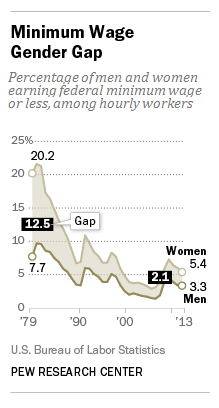Substantially more women than men are in jobs that pay the minimum wage or less, according to U.S. Bureau of Labor Statistics data analyzed by the Pew Research Center. Men make up a larger share of the U.S. labor force than women (53%-47%). But among those who earn the minimum wage or less, 62% are women and 38% are men.

Congress is debating a hike to the federal minimum wage (currently $7.25 per hour), an idea that has strong support among the American public. Last week, a bill backed by the White House that would raise the federal minimum wage to $10.10 failed to advance in the Senate. (Meanwhile, 21 states and some cities have a minimum wage higher than the federal minimum.)
In 2012, women’s hourly wages were 84% those of men – meaning that women earned about 84 cents for every $1 made by men, a gender pay gap of 16 cents, according to a Pew Research Center report.
Among those paid by the hour, some 5.4% of women (2.1 million workers) made the federal minimum wage or less in 2013. For men, that share is 3.3%, or 1.2 million workers. (Some people may be paid below the federal minimum wage, including those who make tips.) The difference has narrowed since 1979, when the share of hourly workers who earned federal minimum wage or less was 20.2% for women and 7.7% for men.
The biggest gap is between young women and young men. Among hourly workers ages 20 to 24, some 10.0% of women made the federal minimum wage or less in 2013, compared with 5.8% of men. By comparison, the gender gap narrows for older workers. Among hourly workers ages 30 to 34, some 4.0% of women made the federal minimum wage or less, compared with 2.7% of men. Among workers ages 60 to 64, women and men are about equally likely to work at the federal minimum wage—1.5% of women did in 2013, compared with 1.2% of men.
